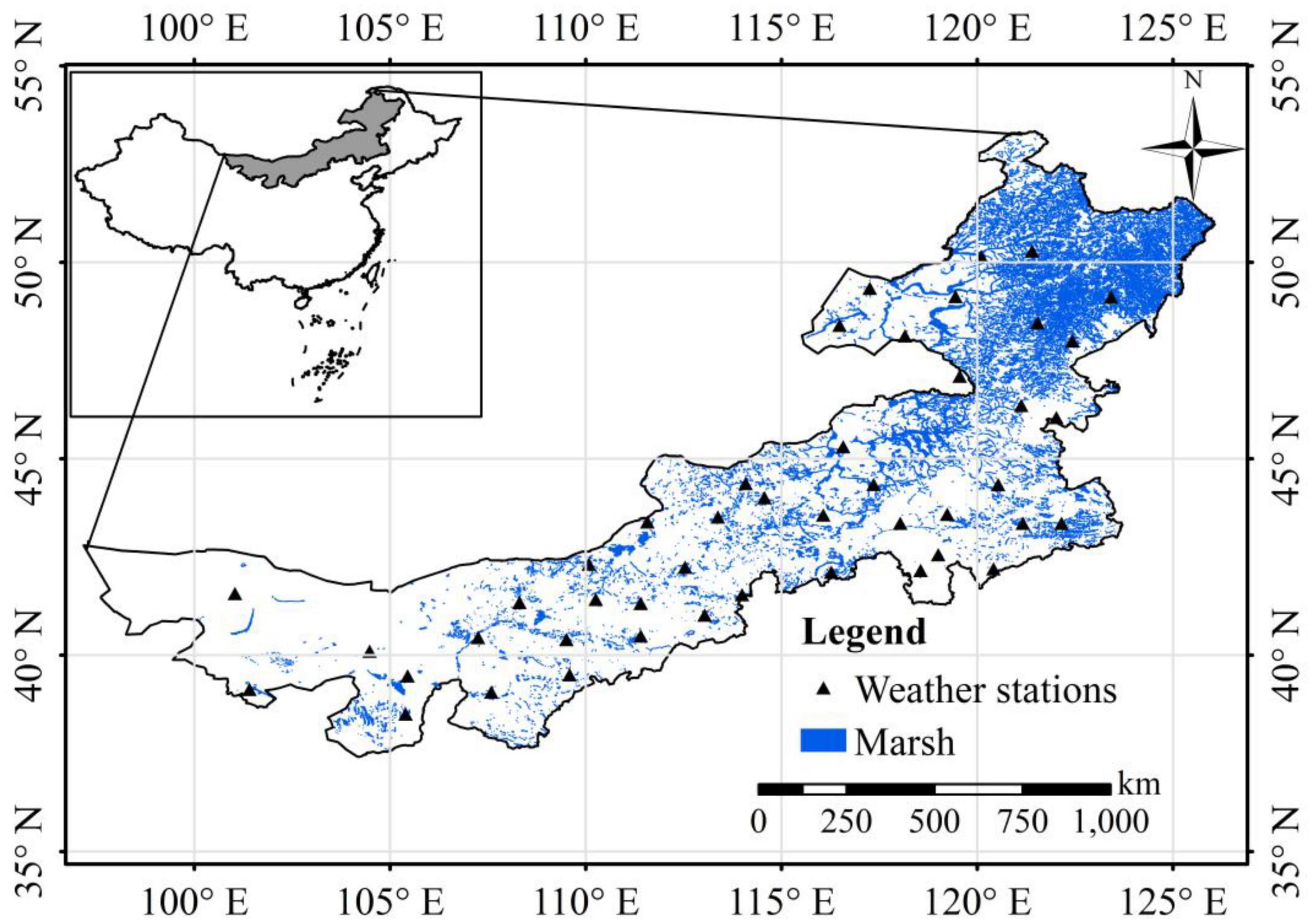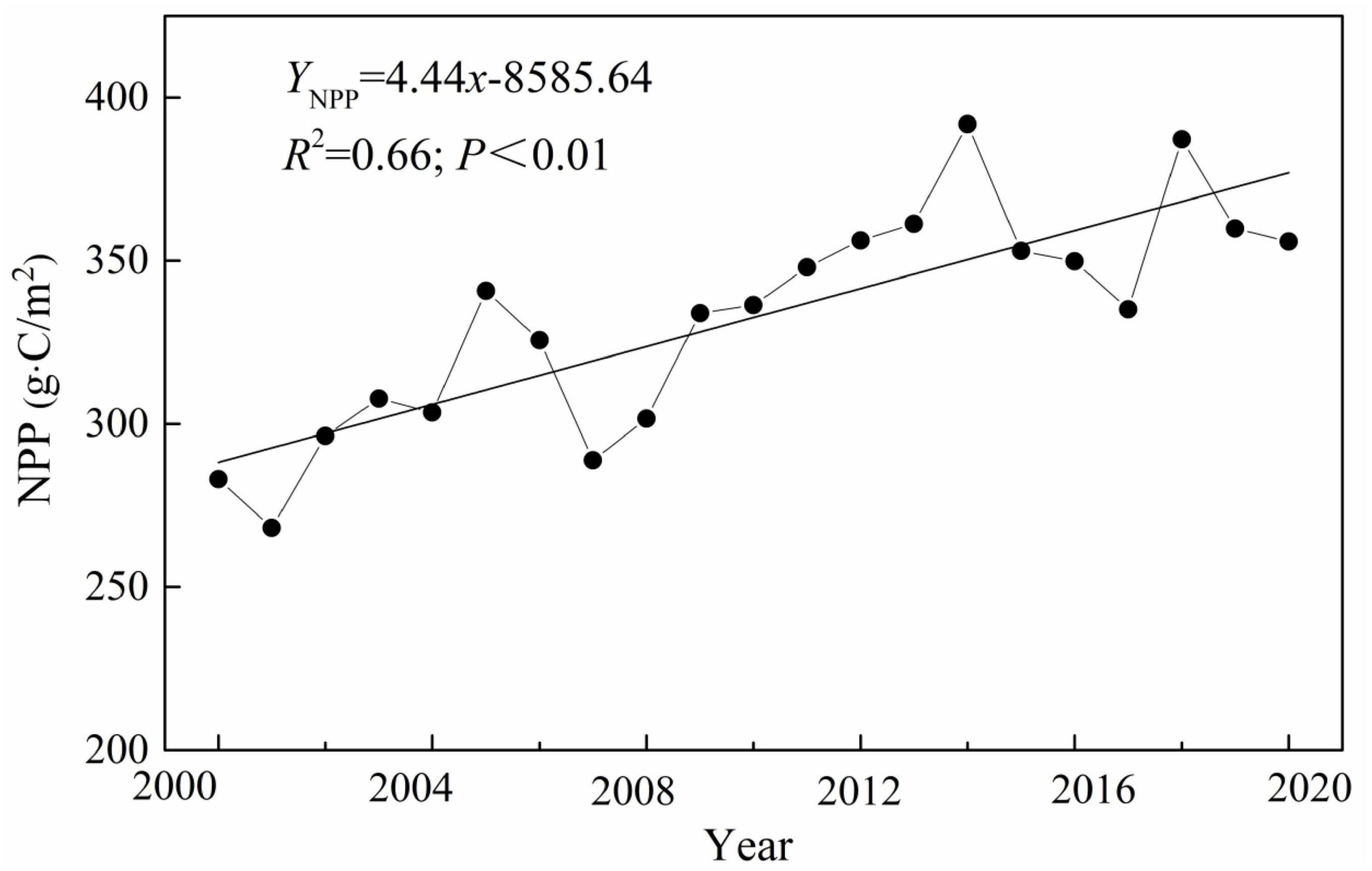- 1Northeast Institute of Geography and Agroecology, Chinese Academy of Sciences, Changchun, China
- 2University of Chinese Academy of Sciences, Beijing, China
Net primary productivity (NPP) is a vital ecological index that reflects the ecological function and carbon sequestration of marsh ecosystem. Inner Mongolia has a large area of marshes, which play a crucial role in the East Asian carbon cycle. Under the influence of climate change, the NPP of Inner Mongolian marsh has changed significantly in the past few decades, but the spatiotemporal variation in marsh vegetation NPP and how climate change affects marsh NPP remain unclear. This study explores, for the first time, the spatiotemporal variation of marsh NPP and its response to climatic change in Inner Mongolia based on the MODIS-NPP and climate datasets. We find that the long-term average annual NPP of marsh is 339.85 g⋅C/m2 and the marsh NPP shows a significantly increasing trend (4.44 g⋅C/m2/a; p < 0.01) over Inner Mongolia during 2000–2020. Spatially, the most prominent increase trend of NPP is mainly distributed in the northeast of the region (Greater Khingan Mountains). The partial correlation results show that increasing autumn and summer precipitation can increase the NPP of marsh vegetation over Inner Mongolia. Regarding the temperature effects, we observe a strong asymmetric effect of maximum (Tmax) and minimum (Tmin) temperature on annual NPP. A high spring Tmax can markedly increase marsh NPP in Inner Mongolia, whereas a high Tmin can significantly reduce it. In contrast to spring temperature effects on NPP, a high summer Tmax can decrease NPP, whereas a high Tmin can increase it. Our results suggest different effects of seasonal climate conditions on marsh vegetation productivity and highlight the influences of day-time and night-time temperatures. This should be considered in simulating and predicting marsh carbon sequestration in global arid and semi-arid regions.
1. Introduction
As an important ecosystem, wetlands is crucial in supporting biodiversity conservation, climate change regulation and global biogeochemical cycle (Zedler and Kercher, 2005; Fossey and Rousseau, 2016; Gunderson et al., 2016; Savickis et al., 2016; Dinsa and Gemeda, 2019; Pasut et al., 2021; Yang et al., 2022). Marsh is a major type of wetlands ecosystem and significantly affects global carbon cycle (Aukes et al., 2021; Luk et al., 2021; Smith and Kirwan, 2021; Shen et al., 2021a,b, 2022a,b; Wang Y. et al., 2021, 2022). Vegetation is a vital component part of the marsh ecosystems and plays a crucial role in regulating ecosystem carbon balance. Net primary productivity (hereinafter referred to as NPP) is defined as the residual level of dry organic matter produced by photosynthesis after subtracting autotrophic respiration (Field et al., 1995; Imhoff et al., 2004; Haberl et al., 2007; Mu et al., 2013; Zhao et al., 2019), which represents the strength of an ecosystem in terms of its carbon sequestration capacity (Imhoff et al., 2004; Haberl et al., 2007; Keppeler et al., 2021; Saderne et al., 2021). There are many factors that affect marsh productivity, with the climate being one of the most important (Bai et al., 2008; Liang et al., 2015; Hu et al., 2021; Cai et al., 2022; Coleman et al., 2022). Over the past decades, global or regional climate has changed significantly (Shen et al., 2018, 2022c), leading to a significant impact on marsh ecosystem productivity. At present, many researches have explored the influence of climate change on marsh NPP across different areas (Bian et al., 2010; Yang et al., 2020; Molino et al., 2022; Wang Y. et al., 2022), but the potential responses of marsh NPP to climate change are still unknown. In recent years, the area of natural marsh wetlands decreased significantly, and the ecological functions severely degraded (Fluet-Chouinard et al., 2015; Hu et al., 2017; Rietl et al., 2021; Shen et al., 2022a, 2021b). In the context of global change, realizing the productivity changes in marsh vegetation and their driving factors is of great importance for the management and protection of regional marsh ecosystem.
Inner Mongolia ranks third in the total area of marsh in China (Zheng et al., 2019). Most of the Inner Mongolia has an arid to semi-arid climate with a fragile ecological environment and is sensitive to global climate change. Because of climatic change and intensive human activities, the degradation rate of marshes has shown an increasing trend (Shen et al., 2019). Several studies have assessed the changes of marsh NPP and its response to climate change on Inner Mongolia vegetation NPP (Zhu et al., 2005; Zhao et al., 2019). For example, Zhao et al. (2019) investigated the spatiotemporal variations of NPP and its potential influencing factors in Inner Mongolia over 2000–2014. Wang Y. et al., 2021 simulated the spatiotemporal changes of aboveground biomass (AGB) in the grasslands of Inner Mongolian. Zhao et al. (2014) estimated grassland aboveground biomass based on NPP in the Xilingol grassland under different environmental conditions. Ma et al. (2022) explored the spatiotemporal change in NPP and its response to climate change in temperate grasslands of China. Chun et al. (2020) analyzed the impacts of climate variability on the Daihai wetland of central Inner Mongolia. However, most of the studies concentrated on variations of grassland NPP and its response to climate change (Long et al., 2010; Zhang et al., 2011; Han et al., 2015; Lin and Dugarsuren, 2015; Yuan et al., 2015; Chi et al., 2018; Zhao et al., 2019; Wang G. et al., 2021), and the effect of climate change on NPP in the Inner Mongolia marshes remains largely unknown. Some studies demonstrated that marsh wetland has a unique environment, and the responses of marsh NPP to climate changes were different from other ecosystems (Wang Y. et al., 2021, 2022). As climate change could have a distinct impact on marsh NPP for different vegetation types, it is necessary to explore the changes of marsh NPP and its response to climate change in the Inner Mongolia marshes. In addition, previous research has shown the asymmetric effects of day-time and night time temperatures on marsh productivity in Tibet Plateau (Wang Y. et al., 2021). Specifically, warming day-time temperature does not significantly affect marsh productivity, whereas night-time warming can markedly improve the productivity of marshes (Wang Y. et al., 2021). Compared with the Tibetan Plateau, an obvious dry and warm season has been documented in the Inner Mongolia (Hu et al., 2015). However, whether the increases in nighttime and daytime temperatures have an asymmetric impact on NPP of marsh vegetation in Inner Mongolia is still unclear. In view of global asymmetric warming, we need to further assess the influences of night and day temperatures on the NPP of marsh vegetation in Inner Mongolia in seasons.
Using the MODIS NPP and climate datasets from 2000 to 2020, this research assessed the spatial and temporal variation of marsh NPP and its association with climate change in Inner Mongolia. The objective of this paper is to clarify the spatial and temporal variation of marsh NPP and its responses to climate change in Inner Mongolia. The findings contribute to the further understanding of the changes of marsh vegetation and the understanding of the basic biological processes of marsh vegetation in arid and semi-arid regions.
2. Materials and methods
2.1. Study area
Inner Mongolia is located in the northern frontier of China with a total area of approximately 118 × 104 km2. This area is flat, with the Yinshan Mountains and Henan Mountains in the south and the Greater Khingan Mountains in the east (Zhao et al., 2019). The altitude of this region is 1,000–1,200 m. The climatic characteristics vary significantly, from east to west across the sub-humid region, temperate humid region, semi-arid region, arid region and extreme arid region. The combined effect of geographical location and climatic conditions makes the marsh vegetation distribution in Inner Mongolia showing obvious zonal characteristics (Hang et al., 2015). The major marsh vegetation types in Inner Mongolia include Phragmites australis, Carex appendiculata, Typha laxmannii, Acorus calamus, and Bolboschoenus planiculmis (Chuai et al., 2013; Miao et al., 2015).
2.2. Datasets and methods
This study used the MOD17A3-NPP data from 2000 to 2020, which had a spatial resolution of 500 m and were provided by the NASA. Two raster marsh maps covering the Inner Mongolia in 2000 and 2015 (Shen et al., 2021b) were employed to analyze the unchanged marshes. The marsh distribution data was provided by the National Earth System Science Data Center. The meteorological data were obtained by the China Meteorological Data Service Network, including monthly accumulated precipitation and average temperature datasets during 2000–2020. According to previous studies (Peng et al., 2013; Shen et al., 2018), this study used the maximum and the minimum temperatures to represent the daytime and nighttime temperatures, respectively. The spatial distribution of the observation dataset of 45 weather stations throughout Inner Mongolia is shown in Figure 1.
2.3. Methods
The meteorological station data in Inner Mongolia were interpolated into the marsh distribution using the ordinary Kriging method (Shen et al., 2021b, 2022c,d). Subsequently, the data were resampled to a similar resolution as the NPP data. The mean value was corresponding mean values of all pixels in the marsh area of Inner Mongolia (Shen et al., 2022d). Partial correlation analysis was conducted to evaluate the relationship between annual NPP and meteorological variables (Piao et al., 2014; Guo et al., 2021). This method removes the influence of other related variables, so it can effectively evaluate the correlation between two variables (Wu et al., 2015; Li et al., 2021). The partial correlation coefficient (Rxy,z) is calculated as follows:
where Rxy,z is the partial correlation coefficient between x and y while removing the influence of z. Ryz, Rxz, and Rxy represent the partial correlation coefficients between y and z, x and z, and x and y, respectively. T-test was employed to demonstrate the statistical significance of the correlations.
3. Results
3.1. Spatial and temporal variations of NPP in the Inner Mongolia marshes
Spatial heterogeneity was observed for the temporal trend and long-term average of NPP in the Inner Mongolia marsh over the last 20 years (Figure 2). The long-term annual marsh NPP was about 339.85 g⋅C/m2, increasing gradually from southwest to northeast (Figure 3A). The region with higher marsh NPP was mainly in northeastern Inner Mongolia. Among them, about 41.74% of the average marsh NPP was greater than 400 g⋅C/m2, and only 3.49% had an average of less than 100 g⋅C/m2 (Figure 3A). With regard to temporal changes, although marshes in Inner Mongolia had undergone dramatic loss, the unchanged marsh NPP over the Inner Mongolia significantly increased by 4.44 g⋅C/m2/a (p < 0.01) between 2000 and 2020 (Figure 3B). Spatially, the most prominent increasing trend of NPP was observed in the northeast Inner Mongolia (Greater Khingan Mountains). On the contrary, a significant decline of marsh NPP was found in the southwest Inner Mongolia (Figure 3B).
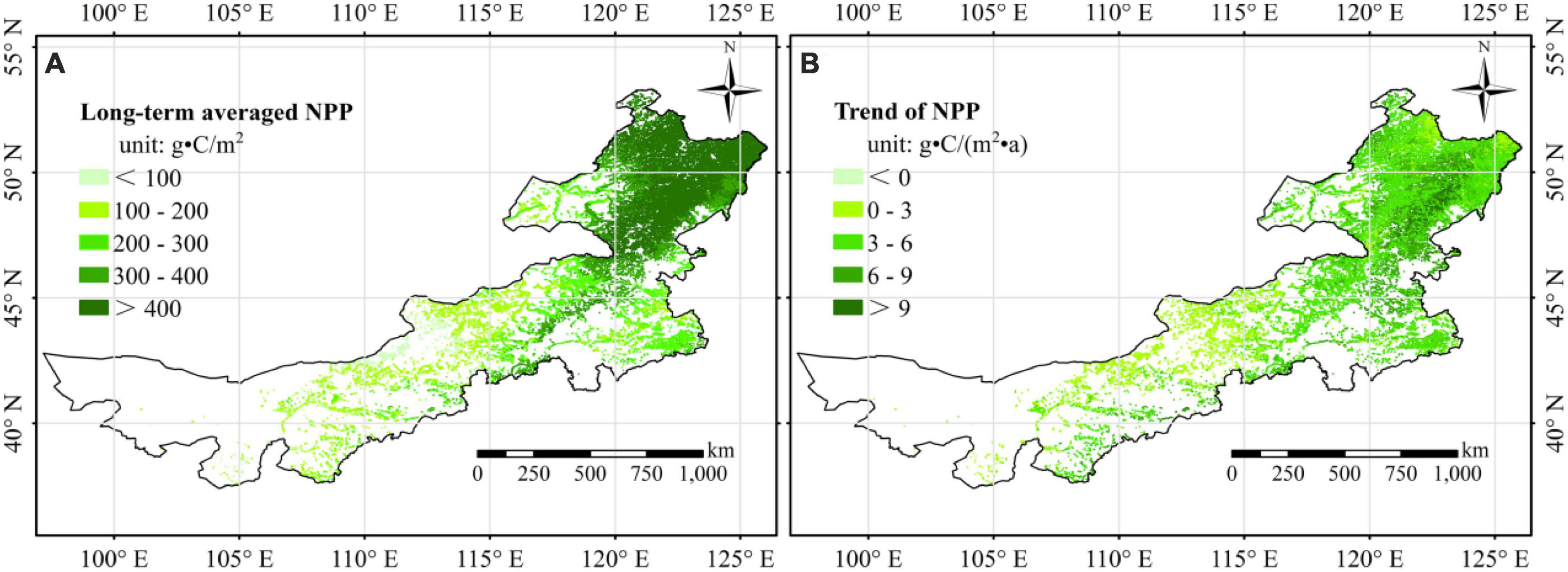
Figure 3. Spatial distributions of long-term average (A) and temporal trends (B) of NPP in Inner Mongolia marshes over 2000–2020.
3.2. Impact of climatic factors on marsh NPP in the study region
The partial correlation results demonstrated a significant positive correlation between annual NPP and annual precipitation, while a weak positive correlation between annual NPP and annual Tmean in Inner Mongolia (Table 1). Spatially, annual NPP was positively related to annual precipitation in most of the areas, and significant positive correlation was mostly distributed in the southeast Inner Mongolia regions (Figure 4A). A positive relationship between mean temperature and NPP was also found in the southeast Inner Mongolia regions (Figure 4B).
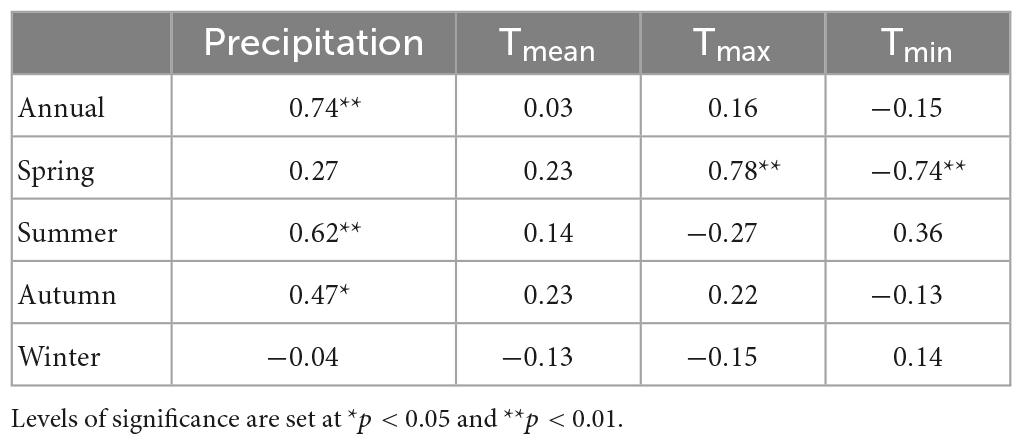
Table 1. Partial correlations between NPP of marsh and seasonal climate variables (precipitation, Tmean, Tmax, and Tmin) in Inner Mongolia.
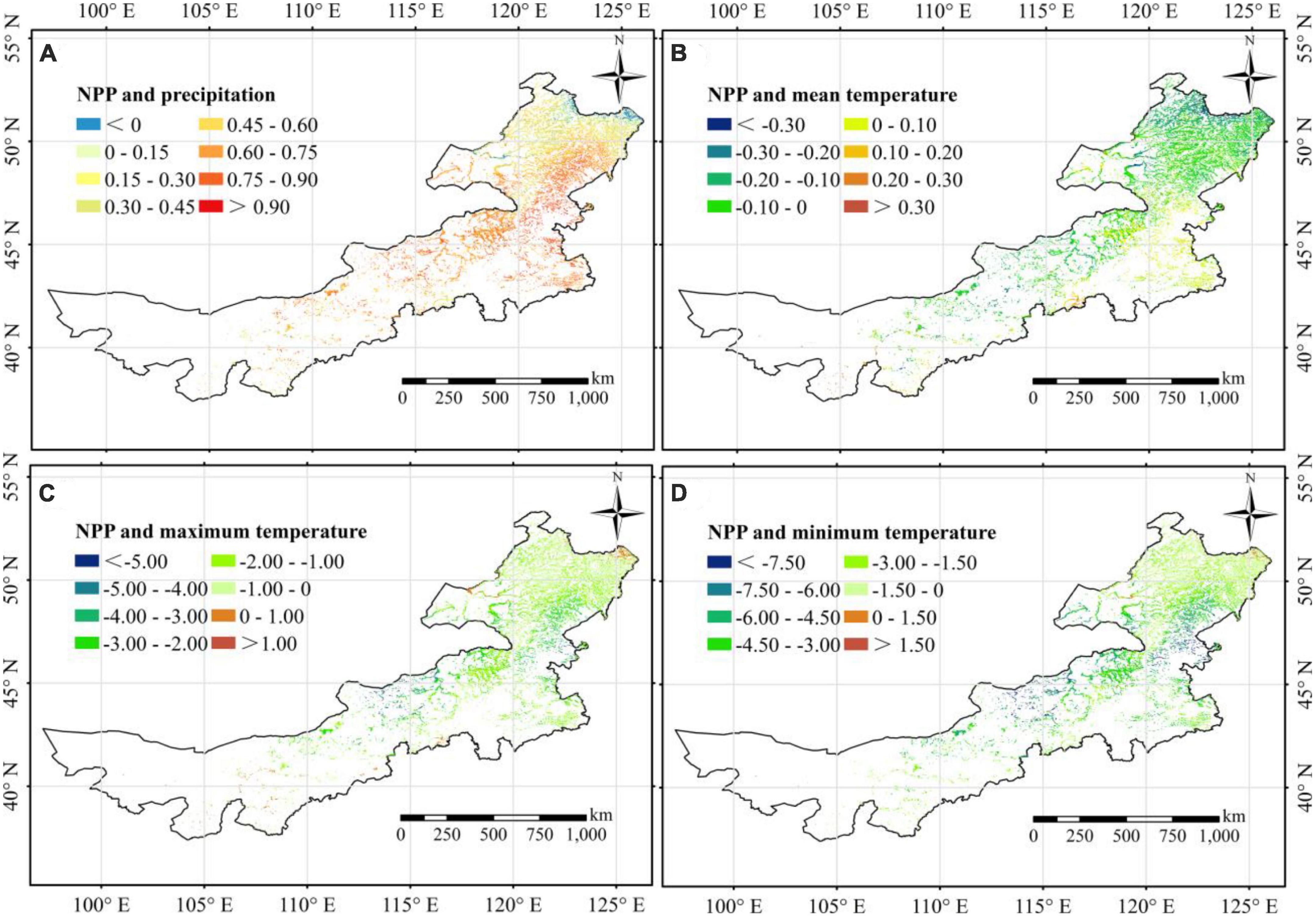
Figure 4. Spatial distributions of the partial correlation coefficients between annual NPP and annual meteorological variables [precipitation (A), mean (B), maximum (C), and minimum (D) temperatures] in the Inner Mongolia marshes during 2000–2020.
To further understand the potential effects of climate change on marsh NPP, partial correlation analysis was conducted between annual NPP and climate factors in different seasons (Table 1; Figures 5, 6). Table 1 shows that annual NPP was significantly positively correlated with summer and autumn precipitation (p < 0.01). For the effects of Tmax and Tmin on NPP, annual NPP had an inverse relationship with spring Tmax and Tmin. A positive correlation was found between annual NPP and spring Tmax, whereas a negative correlation was detected between annual NPP and spring Tmin (Table 1; Figure 5). Spatially, the positive association between productivity and Tmax was mainly observed in the southwest Inner Mongolia regions (Figure 5C). It was found that the spatial correlation between annual productivity and summer Tmin was moderately positive in the northeast Inner Mongolia regions (Figure 6D). By contrast, the association between annual NPP and summer Tmax was negative (Table 1; Figure 6C). Spatially, the asymmetrical effects of daytime and night-time on marsh NPP were mainly concentrated in the northeast Inner Mongolia regions (Figure 6).
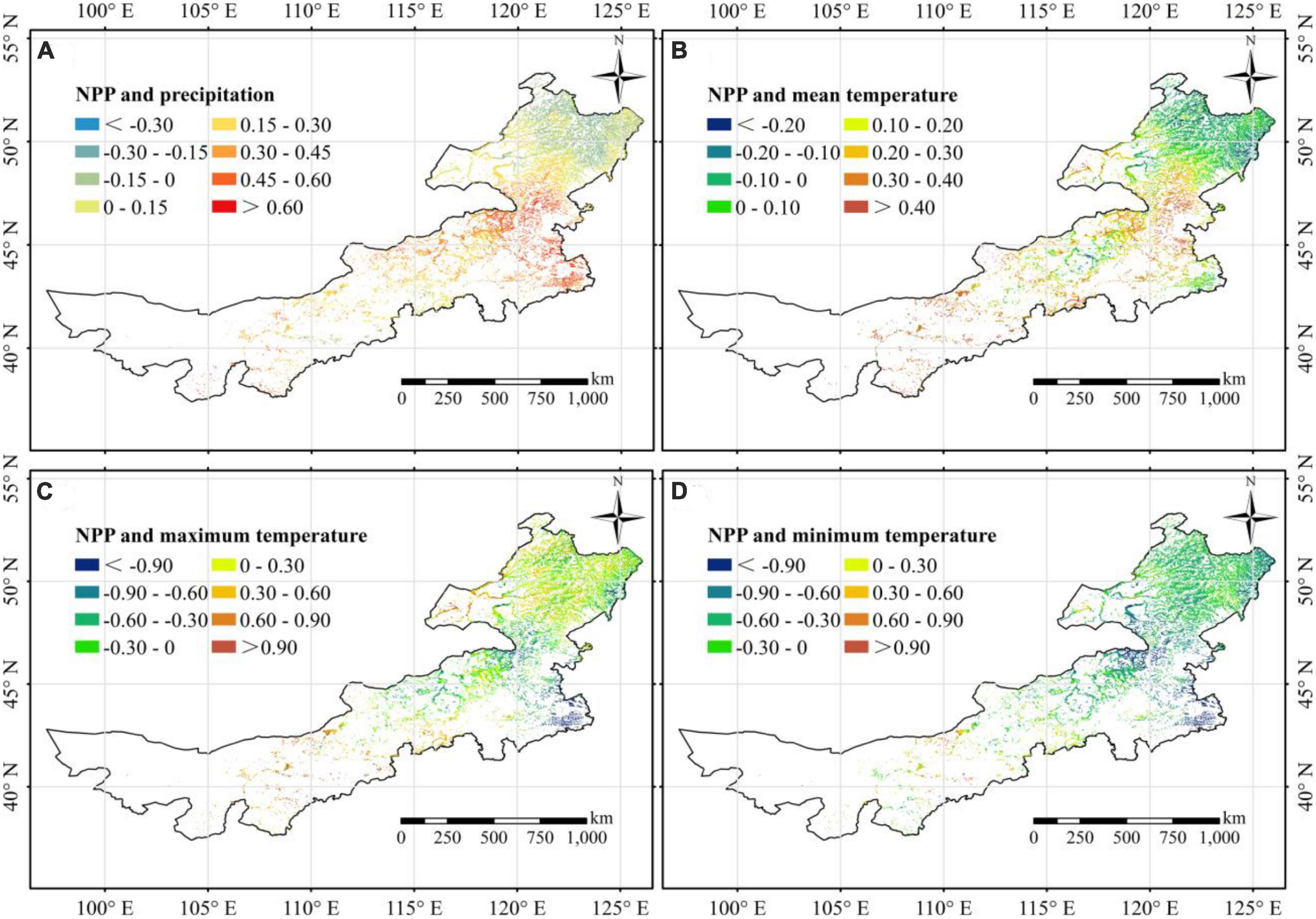
Figure 5. Spatial distributions of the partial correlation coefficients between annual NPP and spring meteorological variables [precipitation (A), mean (B), maximum (C), and minimum (D) temperatures] in the Inner Mongolia marshes during 2000–2020.
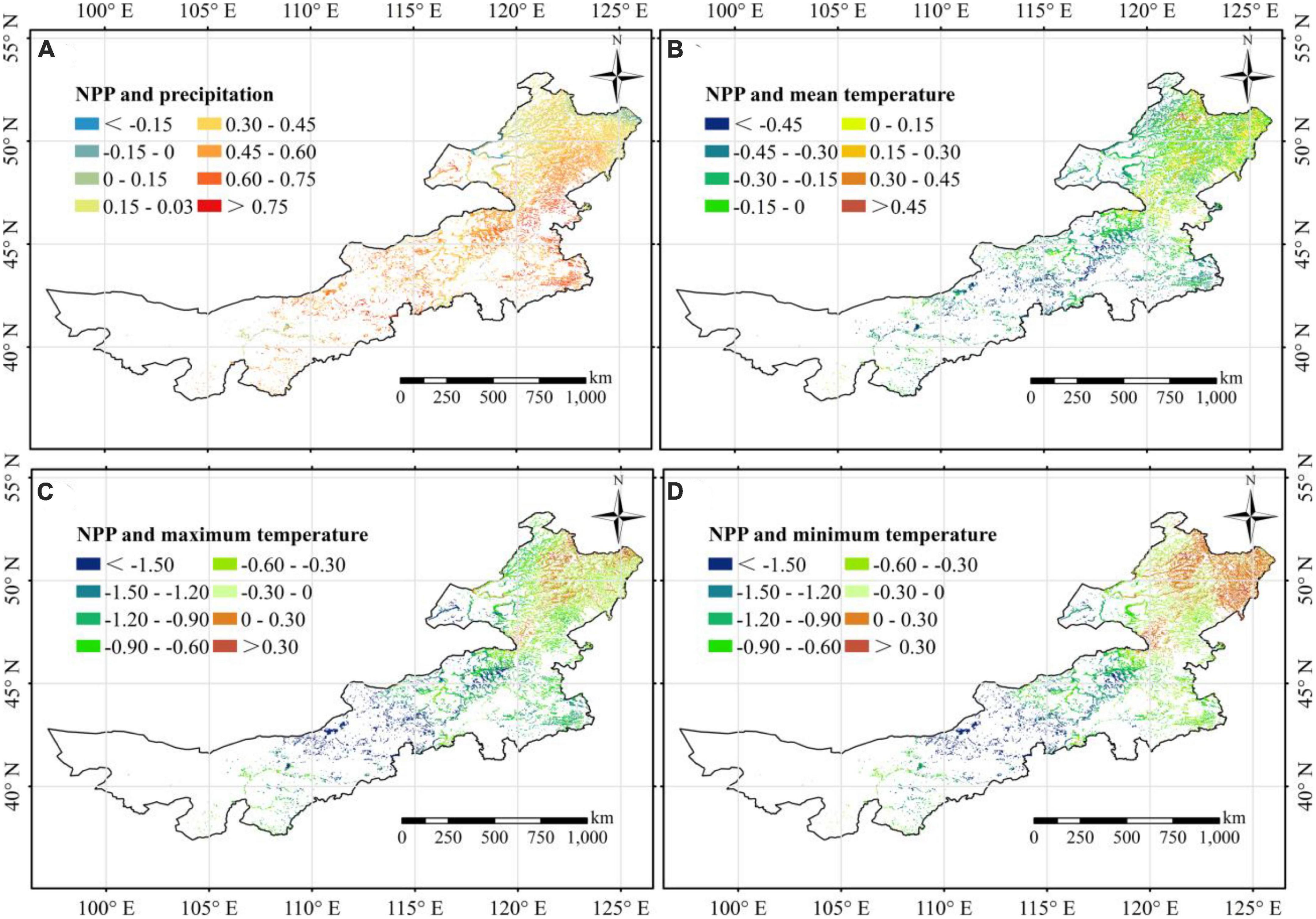
Figure 6. Spatial distributions of the partial correlation coefficients between annual NPP and summer meteorological variables [precipitation (A), mean (B), maximum (C), and minimum (D) temperatures] in the Inner Mongolia marshes during 2000–2020.
4. Discussion
4.1. Change trend of marsh NPP in Inner Mongolia
During the last two decades, the long-term mean average of NPP was approximately 339.85 g⋅C/m2 (Figure 3A). The results were basically consistent with Zhu et al. (2005) who estimated that the annual NPP over Inner Mongolia marsh was approximately 376.8 g⋅C/m2. The average annual NPP over the Inner Mongolia marshes increased significantly (4.44 g⋅C/m2/a; p < 0.01) during the study period, confirming that the growth of marsh plants is getting better in China over the past 20 years (Shen et al., 2021b). Spatially, the highest long-term mean NPP was observed in the northeast Inner Mongolia regions (Figure 3A). The reason may be because that vegetation with high productivity tends to have a high capacity for productivity change caused by climate change (Shen et al., 2020; Wang Y. et al., 2022).
4.2. Factors affecting the vegetation NPP in Inner Mongolia marsh
To determine the responses of marsh vegetation NPP to climate change, the association between meteorological factors and NPP was investigated during 2000–2020. The partial correlation results demonstrated that annual NPP was significantly (p < 0.05) positively correlated with annual precipitation, while weakly (p > 0.05) positively correlated with Tmean in the Inner Mongolia marshes. This implies that increasing annual precipitation can enhance marsh vegetation growth over the Inner Mongolia marshes. Our results confirmed the conclusions of Shen et al. (2019) who have found that precipitation can significantly affect marsh vegetation growth in Inner Mongolia. As a crucial physical disturbance, precipitation can induce marsh vegetation growth in arid regions (Dunton et al., 2001). In different seasons, our findings showed that the increase in autumn and summer precipitation could increase NPP of marsh vegetation over Inner Mongolia (Table 1; Figures 5, 6). Most of Inner Mongolia is relatively arid region, and the increased precipitation can improve the growth of marsh vegetation in Inner Mongolia by stimulating the carbon and water fluxes of the marsh ecosystem, thereby increasing the NPP of marshes (Shen et al., 2021b; Wang Y. et al., 2022). In summer, both temperature and evapotranspiration are the highest, and water demand for marsh vegetation growth is the largest. Therefore, the increase of summer precipitation can remarkably promote the NPP of marsh vegetation. However, it is noteworthy that the marsh distribution data employed in this work may include certain seasonal marsh. High precipitation can increase the distribution of marshes, which obviously increases the NPP of marshes within 500 m × 500 m region. This could partially explain the positive impacts of precipitation on NPP over the Inner Mongolia marshes (Shen et al., 2021b, 2022b).
Regarding the temperature effects, we observed a strong asymmetric effect of spring Tmax and Tmin on annual NPP. A high spring Tmax could markedly increase marsh NPP, whereas a high Tmin could significantly reduce NPP in Inner Mongolia. This may be due to the fact that the warming day-time temperature in spring at the beginning of the growing season enhances the photosynthesis of plants to produce more organic matter, thereby facilitating the growth of marshes and increasing the NPP (Xu and Zhou, 2005; Sun and Mu, 2018). In spring, an increase in Tmin at night can lead to the consumption of more organic matter by respiration (Wang and Han, 2005). This will adversely affect the growth of marsh vegetation and reduce the NPP. In contrast to spring temperature effects on NPP, we found that a high summer Tmax could decrease NPP, whereas a high Tmin could increase NPP (Table 1). The negative effect of summer Tmax on NPP may be attributed to the highest temperature in summer. The continuous accumulation of high temperatures can aggravate soil water evaporation and reduce water consumption in the arid area (Xu and Zhou, 2005; De Boeck et al., 2006). Marsh plants consume more organic matter because of their better respiration rates at night. Hence, they can generate a larger amount of organic matter by promoting and compensating for photosynthesis in the next few days, leading to an improved plant growth (Wang Y. et al., 2022). It has been reported that the plants with adequate supplies of water and nutrients can exert high compensation or overcompensation effect (Belsky, 1986; Shen et al., 2021b). In summer, the Inner Mongolia marshes have good hydrothermal conditions and sufficient nutrition, which is the best period for their overcompensation effect (Li et al., 2018; Park et al., 2019; Wang et al., 2019). Thus, an increase in summer Tmin at night can promote the growth of marsh plants via compensation effects, in which the plants produce more food than their consumption during respiration due to night warming. Such mechanism partially explains the positive association between NPP and summer Tmin in Inner Mongolia.
To understand the change of NPP in the Inner Mongolia marshes, the spatiotemporal alterations of meteorological factors in Inner Mongolia over 2000–2020 were analyzed (Table 2; Figures 7–9). The results showed that annual precipitation was significantly increased (7.014 mm/a) during 2000–2020, which reached an extremely significant level (p < 0.01). The annual temperature (including Tmean, Tmax, and Tmin) in most areas of Inner Mongolia showed an obvious increasing trend (Figure 7). In different seasons, the precipitation in summer and autumn exhibited obvious increasing trends (4.593 and 2.157 mm/a, respectively) (Figures 8, 9). According to the partial correlation data, an increase in autumn and summer precipitation may interpretation the increased vegetation NPP of the Inner Mongolia marsh. By contrast, an increase in spring Tmax may explain the increased NPP of vegetation NPP in the Inner Mongolia marsh. For spatial NPP changes, the most prominent increasing trend of NPP was mainly distributed in the northeast Inner Mongolia regions. It was found that spring Tmax and summer precipitation significantly increased in the northeast Inner Mongolia marshes (Figures 8, 9). Considering that summer precipitation and spring Tmax were significantly correlated with annual NPP in the northeast Inner Mongolia regions (Figure 4), it can be inferred that the increases in summer precipitation and spring temperature are indicative of marsh NPP elevation in this region.
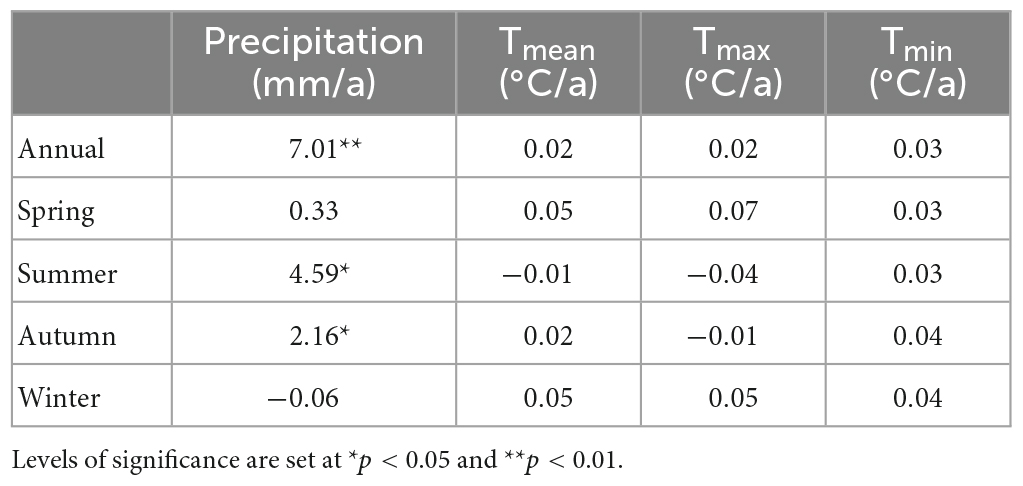
Table 2. Temporal variation trends of climate variables (precipitation, Tmean, Tmax, and Tmin) in the Inner Mongolia marshes from 2000 to 2020.
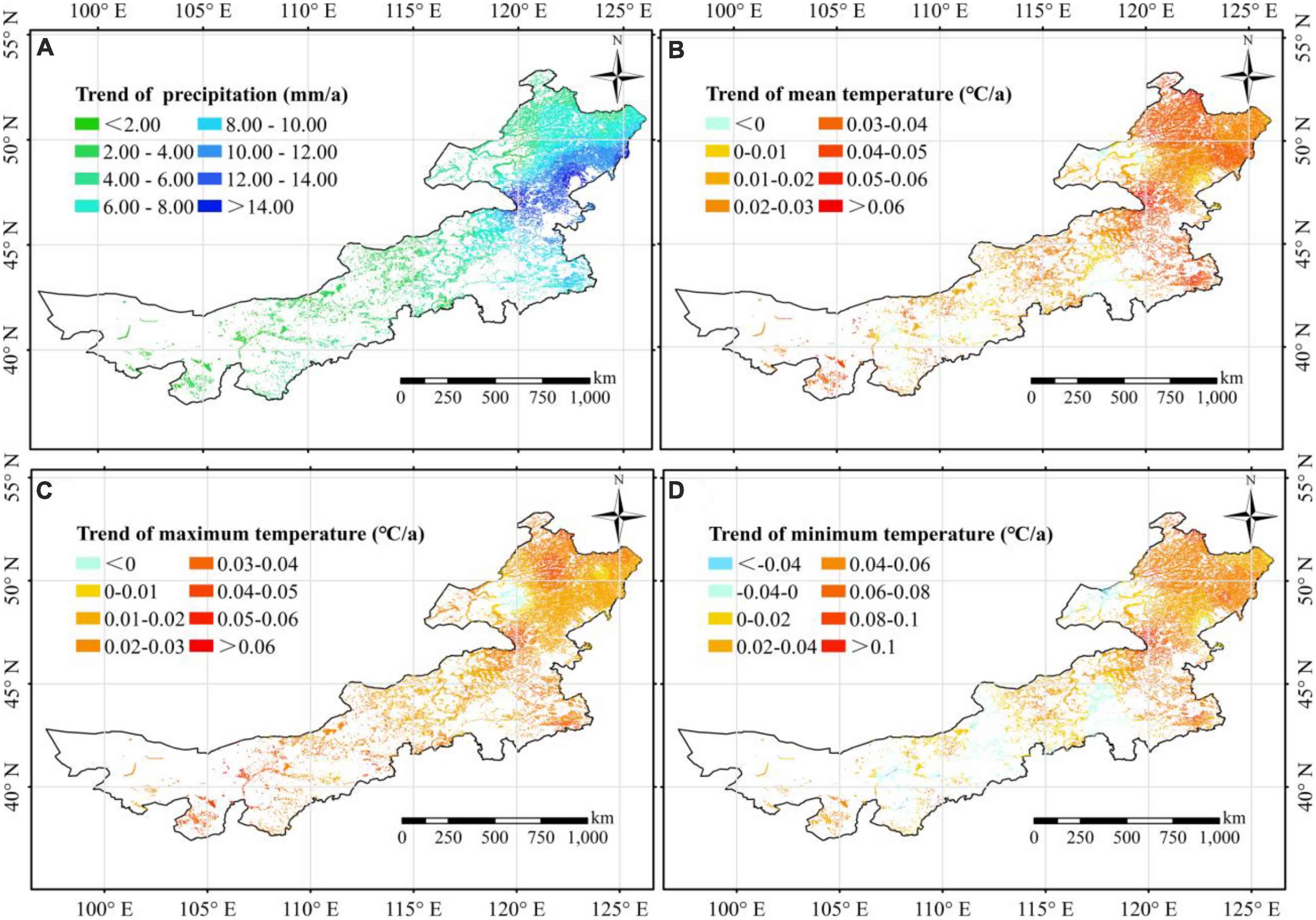
Figure 7. Change trends of annual climate variables [precipitation (A), mean (B), maximum (C), and minimum (D) temperatures] in the Inner Mongolia marshes from 2000 to 2020.
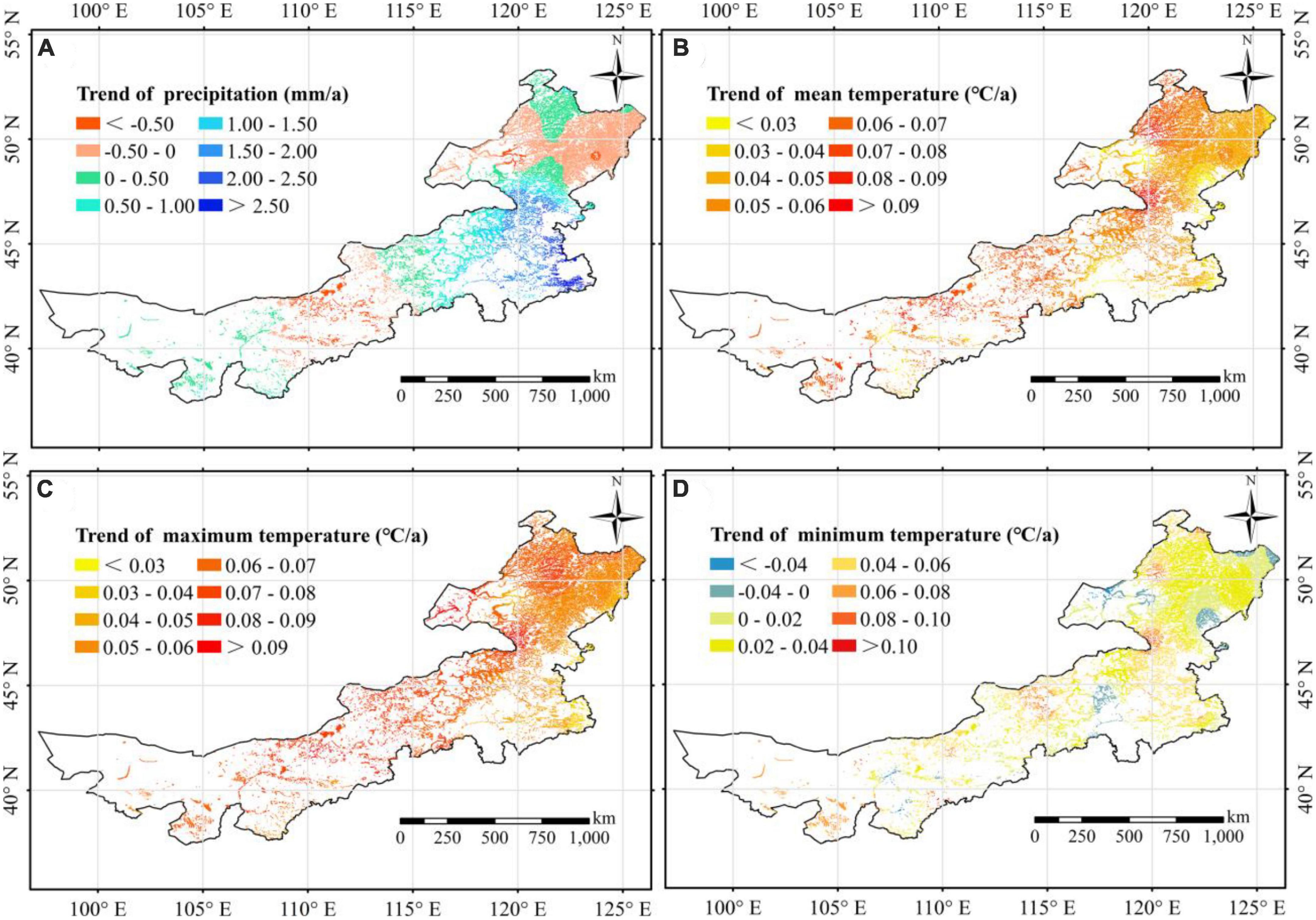
Figure 8. Change trends of spring climate variables [precipitation (A), mean (B), maximum (C), and minimum (D) temperatures] in Inner Mongolia from 2000 to 2020.
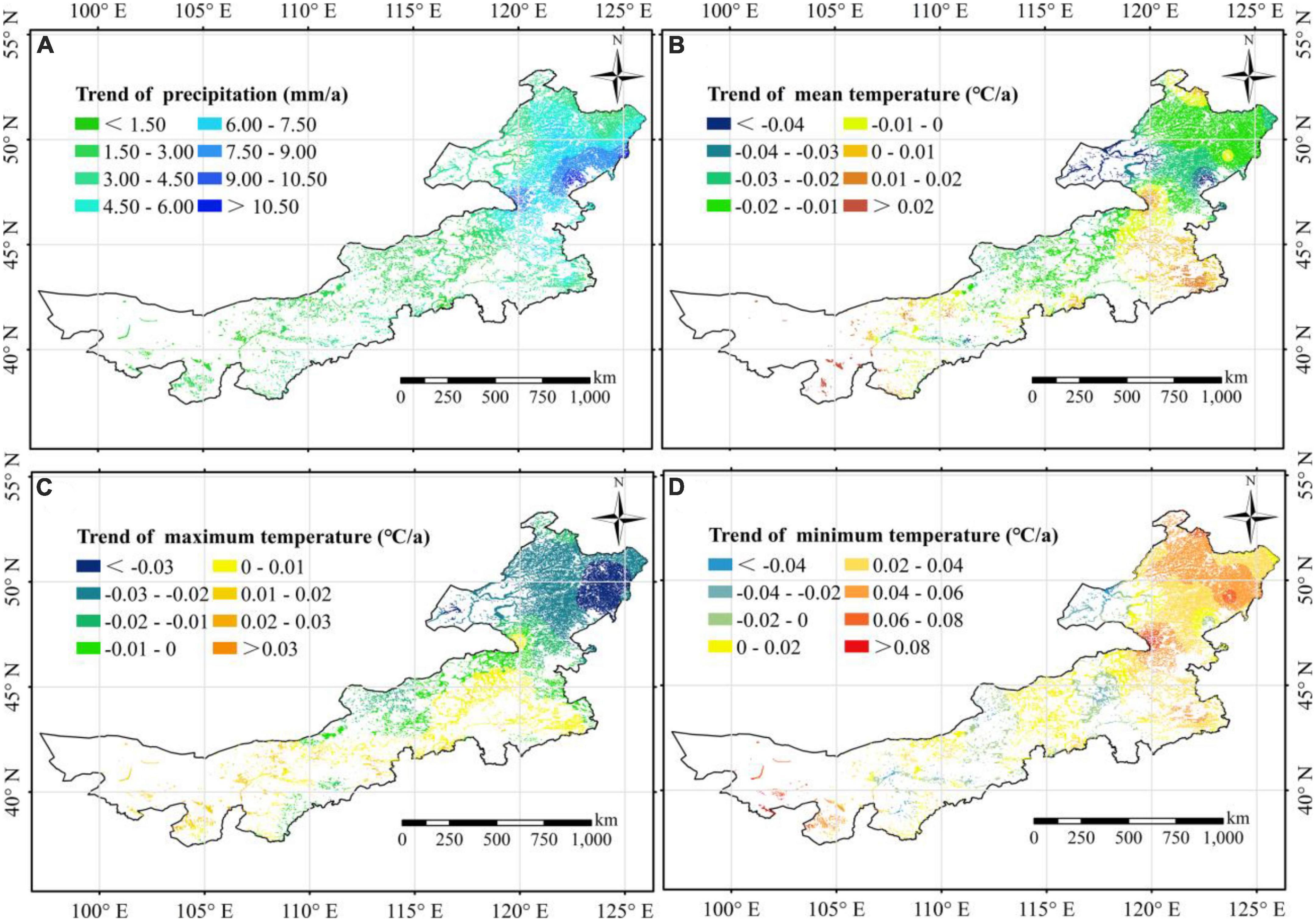
Figure 9. Change trends of summer climate variables [precipitation (A), mean (B), maximum (C), and minimum (D) temperatures] in Inner Mongolia from 2000 to 2020.
4.3. Uncertainty of this study
The limitations of this study should also be noted. First, the accuracy of marsh distribution data was relatively low, owing to the uncertainty in satellite remote sensing data. Second, the actual status of marsh vegetation in 500 m × 500 m regions could not be accurately reflected by the NPP data due to relatively low spatial resolution. Third, the marsh data used in this research might include seasonal marsh wetlands, possibly affecting the change in NPP and its response to climate factors. More accurate remote sensing and measured NPP data should be used to further confirm the results of this study. Finally, some other environmental factors and human activities, such as grazing and land-use change, could also affect vegetation productivity dynamics. Although unchanged marshes have been retrieved to eliminate the impact of human activities, the effects of human activities (such as grazing, farmland, etc.) may not be completely excluded. To further explore the mechanism of NPP changes in the Inner Mongolia marshes, further studies are needed to determine the effects of human activities and other environmental factors on marsh NPP in Inner Mongolia.
5. Conclusion
Based on the MODIS-NPP and climate datasets, this study explored the spatiotemporal variations of NPP and its influential factors in Inner Mongolia during 2000–2020. The results demonstrated that the NPP of Inner Mongolia marsh had a significantly increasing trend (4.44 g⋅C/m2/a; p < 0.01) between 2000 and 2020. The long-term annual mean NPP of marsh was about 339.85 g⋅C/m2. The most prominent increasing trend of NPP was found in the northeast Inner Mongolia (Greater Khingan Mountains). In terms of climate impacts, increases in spring and autumn precipitation could significantly increase marsh NPP in Inner Mongolia. We observed a strong asymmetric effect of Tmax and Tmin on annual NPP. Notably, a high spring Tmax could markedly increase marsh NPP, whereas a high Tmin could significantly reduce NPP in Inner Mongolia. In autumn, nighttime warming could moderately decrease NPP, while daytime warming could moderately increase the annual NPP of vegetation marsh in Inner Mongolia. In contrast to spring temperature effects on NPP, we found that a high summer Tmax could decrease NPP, whereas a high Tmin could increase NPP. This study highlights the different effects of seasonal climate conditions on marsh vegetation productivity and suggests that the influences of day-time and night-time temperatures should be considered in simulating and predicting marsh carbon sequestration in global arid and semi-arid regions, especially under the background of diurnal asymmetric warming.
Data availability statement
The original contributions presented in this study are included in the article/supplementary material, further inquiries can be directed to the corresponding authors.
Author contributions
YW, JZ, XS, RM, YL, and LW: data curation and writing—original draft. XS: methodology and writing—review and editing. ST and MJ: supervision. ST: visualization and investigation. XL: conceptualization and methodology. All authors contributed to the article and approved the submitted version.
Funding
This work was funded by the National Natural Science Foundation of China (41971065), the Youth Innovation Promotion Association, CAS (2019235), the Natural Science Foundation of Jilin Province (20210101104JC), the Key Research Program of Frontier Sciences, CAS (ZDBS-LY-7019), the Innovation Team Project of Northeast Institute of Geography and Agroecology, CAS (2022CXTD02), the Key S&T Special Projects in Jilin Province (20230303005SF), and the Strategic Priority Research Program of the Chinese Academy of China (XDA23060402).
Conflict of interest
The authors declare that the research was conducted in the absence of any commercial or financial relationships that could be construed as a potential conflict of interest.
Publisher’s note
All claims expressed in this article are solely those of the authors and do not necessarily represent those of their affiliated organizations, or those of the publisher, the editors and the reviewers. Any product that may be evaluated in this article, or claim that may be made by its manufacturer, is not guaranteed or endorsed by the publisher.
References
Aukes, P. J., Schiff, S. L., Venkiteswaran, J. J., Elgood, R. J., and Spoelstra, J. (2021). Size-based characterization of freshwater dissolved organic matter finds similarities within a waterbody type across different Canadian ecozones. Limnol. Oceanogr. Lett. 6, 85–95. doi: 10.1002/lol2.10180
Bai, Y., Wu, J., Xing, Q., Pan, Q., Huang, J., Yang, D., et al. (2008). Primary production and rain use efficiency across a precipitation gradient on the Mongolia plateau. Ecology 89, 2140–2153. doi: 10.1890/07-0992.1
Belsky, A. J. (1986). Does herbivory benefit plants? A review of the evidence. Am. Nat. 127, 870–892. doi: 10.2307/2461421
Bian, J., Li, A., and Wei, D. (2010). Estimation and analysis of net primary productivity of ruoergai wetland in china for the recent 10 years based on remote sensing. Procedia Environ. Sci. 2, 288–301. doi: 10.1016/j.proenv.2010.10.035
Cai, X., Qin, Q., Shen, J., and Zhang, Y. J. (2022). Bifurcate responses of tidal range to sea-level rise in estuaries with marsh evolution. Limnol. Oceanogr. Lett. 7, 210–217. doi: 10.1002/lol2.10256
Chi, D., Wang, H., Li, X., Liu, H., and Li, X. (2018). Assessing the effects of grazing on variations of vegetation NPP in the Xilingol Grassland, China, using a grazing pressure index. Ecol. Indic. 88, 372–383. doi: 10.1016/j.ecolind.2018.01.051
Chuai, X. W., Huang, X. J., Wang, W. J., and Bao, G. (2013). NDVI, temperature and precipitation changes and their relationships with different vegetation types during 1998–2007 in Inner Mongolia, China. Int. J. Climatol. 33, 1696–1706. doi: 10.1002/joc.3543
Chun, X., Qin, F. Y., Zhou, H. J., Dan, D., Xia, Y. Y., and Ulambadrakh, K. (2020). Effects of climate variability and land use/land cover change on the Daihai wetland of central Inner Mongolia over the past decades. J. Mt. Sci. 17, 3070–3084. doi: 10.1007/s11629-020-6108-1
Coleman, D. J., Schuerch, M., Temmerman, S., Guntenspergen, G., Smith, C. G., and Kirwan, M. L. (2022). Reconciling models and measurements of marsh vulnerability to sea level rise. Limnol. Oceanogr. Lett. 7, 140–149. doi: 10.1002/lol2.10230
De Boeck, H. J., Lemmens, C. M., Bossuyt, H., Malchair, S., Carnol, M., Merckx, R., et al. (2006). How do climate warming and plant species richness affect water use in experimental grasslands? Plant Soil 288, 249–261. doi: 10.1007/s11104-006-9112-5
Dinsa, T. T., and Gemeda, D. O. (2019). The role of wetlands for climate change mitigation and biodiversity conservation. J. Appl. Sci. Environ. Manag. 23, 1297–1300. doi: 10.4314/jasem.v23i7.16
Dunton, K. H., Hardegree, B., and Whitledge, T. E. (2001). Response of estuarine marsh vegetation to interannual variations in precipitation. Estuaries 24, 851–861. doi: 10.2307/1353176
Field, C. B., Randerson, J. T., and Malmstroem, C. M. (1995). Global net primary production: combining ecology and remote sensing. Remote Sens. Environ. 51, 74–88. doi: 10.1016/0034-4257(94)00066
Fluet-Chouinard, E., Lehner, B., Rebelo, L. M., Papa, F., and Hamilton, S. K. (2015). Development of a global inundation map at high spatial resolution from topographic downscaling of coarse-scale remote sensing data. Remote Sens. Environ. 158, 348–361. doi: 10.1016/j.rse.2014.10.015
Fossey, M., and Rousseau, A. N. (2016). Can isolated and riparian wetlands mitigate the impact of climate change on watershed hydrology? A case study approach. J. Environ. Manag. 184, 327–339. doi: 10.1016/j.jenvman.2016.09.043
Gunderson, L. H., Cosens, B., and Garmestani, A. S. (2016). Adaptive governance of riverine and wetland ecosystem goods and services. J. Environ. Manag. 183, 353–360. doi: 10.1016/j.jenvman.2016.05.024
Guo, D., Song, X., Hu, R., Cai, S., Zhu, X., and Hao, Y. (2021). Grassland type-dependent spatiotemporal characteristics of productivity in Inner Mongolia and its response to climate factors. Sci. Total Environ. 775:145644. doi: 10.1016/j.scitotenv.2021.145644
Haberl, H., Erb, K. H., Krausmann, F., Gaube, V., Bondeau, A., Plutzar, C., et al. (2007). Quantifying and mapping the human appropriation of net primary production in earth’s terrestrial ecosystems. Proc. Natl. Acad. Sci. U. S. A. 104, 12942–12947. doi: 10.1073/pnas.0704243104
Han, F., Zhang, Q., Buyantuev, A., Niu, J., Liu, P., Li, X., et al. (2015). Effects of climate change on phenology and primary productivity in the desert steppe of Inner Mongolia. J. Arid Land 7, 251–263. doi: 10.1007/s40333-014-0042-4
Hang, S. Z., Shan, P., and Bao, L. (2015). “Climate change and Inner Mongolia,” in Climate risk and resilience in China, eds R. Nadin, S. Opitz-Stapleton, and Y. L. Xu (London: Routledge), 242–271.
Hu, Q., Pan, F., Pan, X., Zhang, D., Li, Q., Pan, Z., et al. (2015). Spatial analysis of climate change in Inner Mongolia during 1961–2012, China. Appl. Geogr. 60, 254–260. doi: 10.1016/j.apgeog.2014.10.009
Hu, S., Niu, Z., Chen, Y., Li, L., and Zhang, H. (2017). Global wetlands: potential distribution, wetland loss, and status. Sci. Total Environ. 586, 319–327. doi: 10.1016/j.scitotenv.2017.02.001
Hu, Z., Borsje, B. W., van Belzen, J., Willemsen, P. W., Wang, H., Peng, Y., et al. (2021). Mechanistic modeling of marsh seedling establishment provides a positive outlook for coastal wetland restoration under global climate change. Geophys. Res. Lett. 48:e2021GL095596. doi: 10.1029/2021GL095596
Imhoff, M. L., Bounoua, L., DeFries, R., Lawrence, W. T., Stutzer, D., Tucker, C. J., et al. (2004). The consequences of urban land transformation on net primary productivity in the United States. Remote Sens. Environ. 89, 434–443. doi: 10.1016/j.rse.2003.10.015
Keppeler, F. W., Olin, J. A., López-Duarte, P. C., Polito, M. J., Hooper-Bùi, L. M., Taylor, S. S., et al. (2021). Body size, trophic position, and the coupling of different energy pathways across a saltmarsh landscape. Limnol. Oceanogr. Lett. 6, 360–368. doi: 10.1002/lol2.10212
Li, C., Wang, J., Hu, R., Yin, S., Bao, Y., and Ayal, D. Y. (2018). Relationship between vegetation change and extreme climate indices on the Inner Mongolia Plateau, China, from 1982 to 2013. Ecol. Indic. 89, 101–109. doi: 10.1016/j.ecolind.2018.01.066
Li, H., Zhang, H., Li, Q., Zhao, J., Guo, X., Ying, H., et al. (2021). Vegetation productivity dynamics in response to climate change and human activities under different topography and land cover in Northeast China. Remote Sens. 13:975. doi: 10.3390/rs13050975
Liang, W., Yang, Y., Fan, D., Guan, H., Zhang, T., Long, D., et al. (2015). Analysis of spatial and temporal patterns of net primary production and their climate controls in China from 1982 to 2010. Agric. For. Meteorol. 204, 22–36. doi: 10.1016/j.agrformet.2015.01.015
Lin, C., and Dugarsuren, N. (2015). Deriving the spatiotemporal NPP pattern in terrestrial ecosystems of Mongolia using MODIS imagery. Photogramm. Eng. Remote Sens. 81, 587–598. doi: 10.14358/pers.81.7.587
Long, H. L., Li, X. B., Wang, H., Wei, D. D., and Zhang, C. (2010). Net primary productivity (NPP) of grassland ecosystem and its relationship with climate in Inner Mongolia (in Chinese). Acta Ecol. Sin. 30, 1367–1378.
Luk, S. Y., Todd-Brown, K., Eagle, M., McNichol, A. P., Sanderman, J., Gosselin, K., et al. (2021). Soil organic carbon development and turnover in natural and disturbed salt marsh environments. Geophys. Res. Lett. 48:e2020GL090287. doi: 10.1029/2020GL090287
Ma, R., Xia, C., Liu, Y., Wang, Y., Zhang, J., Shen, X., et al. (2022). Spatiotemporal change of net primary productivity and its response to climate change in temperate grasslands of china. Front. Plant Sci. 13:899800. doi: 10.3389/fpls.2022.899800
Miao, L., Jiang, C., Xue, B., Liu, Q., He, B., Nath, R., et al. (2015). Vegetation dynamics and factor analysis in arid and semi-arid Inner Mongolia. Environ. Earth Sci. 73, 2343–2352. doi: 10.1007/s12665-014-3582-1
Molino, G. D., Carr, J. A., Ganju, N. K., and Kirwan, M. L. (2022). Variability in marsh migration potential determined by topographic rather than anthropogenic constraints in the Chesapeake Bay region. Limnol. Oceanogr. Lett. 7, 321–331. doi: 10.1002/lol2.10262
Mu, S., Zhou, S., Chen, Y., Li, J., Ju, W., and Odeh, I. O. A. (2013). Assessing the impact of restoration-induced land conversion and management alternatives on net primary productivity in Inner Mongolian grassland, China. Glob. Planet. Change 108, 29–41. doi: 10.1016/j.gloplacha.2013.06.007
Park, T., Chen, C., Macias-Fauria, M., Tømmervik, H., Choi, S., Winkler, A., et al. (2019). Changes in timing of seasonal peak photosynthetic activity in northern ecosystems. Glob. Change Biol. 25, 2382–2395. doi: 10.1111/gcb.14638
Pasut, C., Tang, F. H., Hamilton, D., Riley, W. J., and Maggi, F. (2021). Spatiotemporal assessment of GHG emissions and nutrient sequestration linked to agronutrient runoff in global wetlands. Glob. Biogeochem. Cycles 35:e2020GB006816. doi: 10.1029/2020GB006816
Peng, S., Piao, S., Ciais, P., Myneni, R. B., Chen, A., Chevallier, F., et al. (2013). Asymmetric effects of daytime and night-time warming on northern hemisphere vegetation. Nature 501, 88–92. doi: 10.1038/nature12434
Piao, S., Nan, H., Huntingford, C., Ciais, P., Friedlingstein, P., Sitch, S., et al. (2014). Evidence for a weakening relationship between interannual temperature variability and northern vegetation activity. Nat. Commun. 5:5018. doi: 10.1038/ncomms6018
Rietl, A. J., Megonigal, J. P., Herbert, E. R., and Kirwan, M. L. (2021). Vegetation type and decomposition priming mediate brackish marsh carbon accumulation under interacting facets of global change. Geophys. Res. Lett. 48:e2020GL092051. doi: 10.1029/2020GL092051
Saderne, V., Fusi, M., Thomson, T., Dunne, A., Mahmud, F., Roth, F., et al. (2021). Total alkalinity production in a mangrove ecosystem reveals an overlooked Blue Carbon component. Limnol. Oceanogr. Lett. 6, 61–67. doi: 10.1002/lol2.10170
Savickis, J., Bottacin-Busolin, A., Zaramella, M., Sabokrouhiyeh, N., and Marion, A. (2016). Effect of a meandering channel on wetland performance. J. Hydrol. 535, 204–210. doi: 10.1016/j.jhydrol.2016.01.082
Shen, X., Jiang, M., Lu, X., Liu, X., Liu, B., Zhang, J., et al. (2021a). Aboveground biomass and its spatial distribution pattern of herbaceous marsh vegetation in China. Sci. China Earth Sci. 64, 1115–1125. doi: 10.1007/s11430-020-9778-7
Shen, X., Liu, B., and Lu, X. (2018). Asymmetric effects of daytime and nighttime warming on spring phenology in the temperate grasslands of China. Agric. For. Meteorol. 259, 240–249. doi: 10.1016/j.agrformet.2018.05.006
Shen, X., Liu, B., Henderson, M., Wang, L., Jiang, M., and Lu, X. (2022a). Vegetation greening, extended growing seasons, and temperature feedbacks in warming temperate grasslands of China. J. Clim. 35, 5103–5117. doi: 10.1175/JCLI-D-21-0325.1
Shen, X., Liu, B., Jiang, M., and Lu, X. (2020). Marshland loss warms local land surface temperature in China. Geophys. Res. Lett. 47:e2020GL087648. doi: 10.1029/2020GL087648
Shen, X., Liu, B., Jiang, M., Wang, Y., Wang, L., Zhang, J., et al. (2021b). Spatiotemporal change of marsh vegetation and its response to climate change in China from 2000 to 2019. J. Geophys. Res. Biogeosci. 126:e2020JG006154. doi: 10.1029/2020JG006154
Shen, X., Liu, Y., Liu, B., Zhang, J., Wang, L., Lu, X., et al. (2022b). Effect of shrub encroachment on land surface temperature in semi-arid areas of temperate regions of the Northern Hemisphere. Agric. For. Meteorol. 320:108943. doi: 10.1016/j.agrformet.2022.108943
Shen, X., Liu, Y., Zhang, J., Wang, Y., Ma, R., Liu, B., et al. (2022c). Asymmetric impacts of diurnal warming on vegetation carbon sequestration of marshes in the Qinghai Tibet Plateau. Glob. Biogeochem. Cycles 36:e2022GB007396. doi: 10.1029/2022GB007396
Shen, X., Jiang, M., and Lu, X. (2022d). Diverse impacts of day and night temperature on spring phenology in freshwater marshes of the Tibetan Plateau. Limnol. Oceanogr. Lett. 8, 323–329. doi: 10.1002/lol2.10285
Shen, X., Xue, Z., Jiang, M., and Lu, X. (2019). Spatiotemporal change of vegetation coverage and its relationship with climate change in freshwater marshes of Northeast China. Wetlands 39, 429–439. doi: 10.1007/s13157-018-1072-z
Smith, A. J., and Kirwan, M. L. (2021). Sea level-driven marsh migration results in rapid net loss of carbon. Geophys. Res. Lett. 48:e2021GL092420. doi: 10.1029/2021GL092420
Sun, G., and Mu, M. (2018). Assessing the characteristics of net primary production due to future climate change and CO2 under RCP4.5 in China. Ecol. Complex. 34, 58–68. doi: 10.1016/j.ecocom.2018.04.001
Wang, G., Huang, Y., Wei, Y., Zhang, W., Li, T., and Zhang, Q. (2019). Climate warming does not always extend the plant growing season in Inner Mongolian grasslands: evidence from a 30-year in situ observations at eight experimental sites. J. Geophys. Res. Biogeosci. 124, 2364–2378. doi: 10.1029/2019JG005137
Wang, G., Luo, Z., Huang, Y., Sun, W., Wei, Y., Xiao, L., et al. (2021). Simulating the spatiotemporal variations in aboveground biomass in Inner Mongolian grasslands under environmental changes. Atmos. Chem. Phys. 21, 3059–3071. doi: 10.5194/acp-21-3059-2021
Wang, Y., Shen, X., Jiang, M., Tong, S., and Lu, X. (2021). Spatiotemporal change of aboveground biomass and its response to climate change in marshes of the Tibetan Plateau. Int. J. Appl. Earth Observ. Geoinf. 102:102385. doi: 10.1016/j.jag.2021.102385
Wang, Y., Shen, X., Jiang, M., Tong, S., and Lu, X. (2022). Daytime and nighttime temperatures exert different effects on vegetation net primary productivity of marshes in the western Songnen Plain. Ecol. Indic. 137:108789. doi: 10.1016/j.ecolind.2022.108789
Wang, Z. P., and Han, X. G. (2005). Diurnal variation in methane emissions in relation to plants and environmental variables in the Inner Mongolia marshes. Atmos. Environ. 39, 6295–6305. doi: 10.1016/j.atmosenv.2005.07.010
Wu, D., Zhao, X., Liang, S., Zhou, T., Huang, K., Tang, B., et al. (2015). Time-lag effects of global vegetation responses to climate change. Glob. Change Biol. 21, 3520–3531. doi: 10.1111/gcb.12945
Xu, Z. Z., and Zhou, G. S. (2005). Effects of water stress and high nocturnal temperature on photosynthesis and nitrogen level of a perennial grass Leymus chinensis. Plant Soil 269, 131–139. doi: 10.1007/s11104-004-0397-y
Yang, H., Hu, D., Xu, H., and Zhong, X. (2020). Assessing the spatiotemporal variation of NPP and its response to driving factors in Anhui province, China. Environ. Sci. Pollut. Res. 27, 14915–14932. doi: 10.1007/s11356-020-08006-w
Yang, Y., Moorhead, D. L., Craig, H., Luo, M., Chen, X., Huang, J., et al. (2022). Differential responses of soil extracellular enzyme activities to salinization: implications for soil carbon cycling in tidal wetlands. Glob. Biogeochem. Cycles 36:e2021GB007285. doi: 10.1029/2021GB007285
Yuan, F., Wu, J., Li, A., Rowe, H., Bai, Y., Huang, J., et al. (2015). Spatial patterns of soil nutrients, plant diversity, and aboveground biomass in the Inner Mongolia grassland: before and after a biodiversity removal experiment. Landsc. Ecol. 30, 1737–1750. doi: 10.1007/s10980-015-0154-z
Zedler, J. B., and Kercher, S. (2005). Wetland resources: status, trends, ecosystem services and restorability. Annu. Rev. Environ. Resour. 15, 39–74. doi: 10.1579/0044-7447(2007)36[335:cnwppc]2.0.co;2
Zhang, G., Kang, Y., Han, G., and Sakurai, K. (2011). Effect of climate change over the past half century on the distribution, extent and NPP of ecosystems of Inner Mongolia. Glob. Change Biol. 17, 377–389. doi: 10.1111/j.1365-2486.2010.02237.x
Zhao, F., Xu, B., Yang, X., Jin, Y., Li, J., Xia, L., et al. (2014). Remote sensing estimates of grassland aboveground biomass based on MODIS net primary productivity (NPP): a case study in the Xilingol grassland of Northern China. Remote Sens. 6. doi: 10.3390/rs6065368
Zhao, Y., Liu, H., Zhang, A., Cui, X., and Zhao, A. (2019). Spatiotemporal variations and its influencing factors of grassland net primary productivity in Inner Mongolia, China during the period 2000–2014. J. Arid Environ. 165, 106–118. doi: 10.1016/j.jaridenv.2019.01.004
Zheng, Y., Liu, H., Zhuo, Y., Li, Z., Liang, C., and Wang, L. (2019). Dynamic changes and driving factors of wetlands in Inner Mongolia Plateau, China. PLoS One 14:e0221177. doi: 10.1371/journal.pone.0221177
Keywords: marsh, net primary productivity, climate change, vegetation, Inner Mongolia
Citation: Wang Y, Zhang J, Shen X, Ma R, Liu Y, Wu L, Tong S, Jiang M and Lu X (2023) Spatiotemporal variation of marsh vegetation productivity and climatic effects in Inner Mongolia, China. Front. Ecol. Evol. 11:1138965. doi: 10.3389/fevo.2023.1138965
Received: 06 January 2023; Accepted: 17 May 2023;
Published: 23 June 2023.
Edited by:
Penghai Wu, Anhui University, ChinaReviewed by:
Bolin Fu, Guilin University of Technology, ChinaJingkuan Sun, Binzhou University, China
Copyright © 2023 Wang, Zhang, Shen, Ma, Liu, Wu, Tong, Jiang and Lu. This is an open-access article distributed under the terms of the Creative Commons Attribution License (CC BY). The use, distribution or reproduction in other forums is permitted, provided the original author(s) and the copyright owner(s) are credited and that the original publication in this journal is cited, in accordance with accepted academic practice. No use, distribution or reproduction is permitted which does not comply with these terms.
*Correspondence: Xiangjin Shen, c2hlbnhpYW5namluQGlnYS5hYy5jbg==; Shouzheng Tong, dG9uZ3Nob3V6aGVuZ0BpZ2EuYWMuY24=
 Yanji Wang
Yanji Wang Jiaqi Zhang
Jiaqi Zhang Xiangjin Shen
Xiangjin Shen Rong Ma1
Rong Ma1